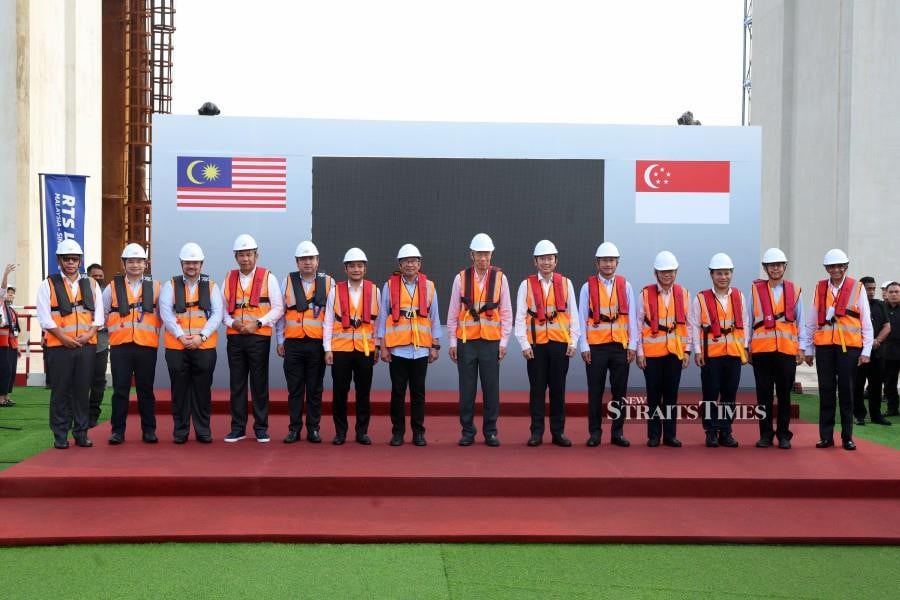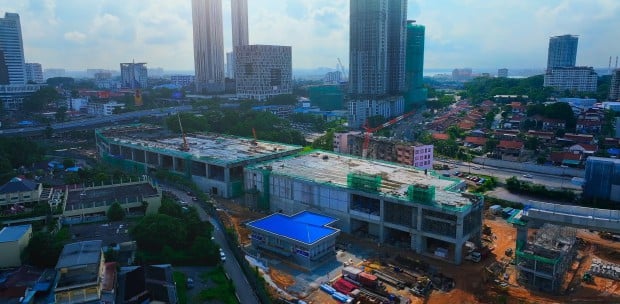JOHOR BARU: The Rapid Transit System Link (RTS Link) journey has so far been a very exciting and 'visionary' project which transcends boundaries and innovations that could serve as a launchpad for many more successful projects not only in the southern region but in the country.
With both Prime Minister Datuk Seri Anwar Ibrahim and his Singaporean counterpart, Lee Hsien Loong, making a grand presence yesterday (January 11) at the project, it has certainly raised its profile not only in the region but it is also making waves far beyond the shores here.
Describing the project as a 'transformative journey', Mass Rapid Transit Corporation Sdn Bhd (MRT Corp) chief executive, Datuk Mohd Zarif Mohd Hashim, said the project has certainly tested the company's capabilities beyond normal norms and practices, thus, making all the challenges rather interesting and exciting.
"So for us at MRT Corp, we view ourselves not only as implementors, but rather as facilitators that facilitate many activities, many improvements, a lot of changes, that Johor Baru is about to embrace," he said.
He said this is a transformative journey that stretches beyond the company's normal scope of work, because it has to also deal with the changes in policies, Standard Operating Procedures (SOPs) and processes.
"The change in how we do things, for example, how we actually cleared immigration, how we pass through the Customs and how we actually design, the walkability, the mobility of the people around the rail infrastructure.
"At the end of the day, what we hope is to be able to deliver value for the rakyat. Not only in terms of the ease of crossing the border but also value in terms of economic growth, attracting investments," he said in an interview here recently.
Mohd Zarif said every stakeholder in the project has the same objective, which is to complete the RTS Link project for the nation, but the challenges are to meet all the demands and expectations, which are varied.
"I don't look at it (all demands and expectations) as a problem but I look at it as an exciting journey because if we are able to do this in RTS, I am sure we will be able to do this (repeat the success) in many other projects in this country. So you have to look at that perspective," he said while describing challenges in the RTS project, which has reached its mid-point progress.
He said for example, the expectation of the people, which is the most important one, is to be able to take the rail and cross the border in the shortest possible time.
"So, if we are able to build such infrastructure, does this mean that would be the end of our journey? What about the distance that the people need to walk, the parking where they can park, the immigration clearance, how many gates to clear the immigration and how long does it take to clear each person?
"So this is where I say building the infrastructure is the normal thing that we are doing like what we did in Kuala Lumpur, but in Johor Baru, it pushes us outside our own scope as we need to meet the demand of the people, we want to deliver that," he said.
Therefore, he said MRT Corp needed to be able to operate, discuss and have dialogues with many different sides and parties to deliver this.
He said through these constant dialogues and meetings, for example, both countries have agreed on both Malaysian Immigration, Customs and Quarantine (ICQ) and Singaporean Customs, Immigration and Quarantine (CIQ) facilities to be co-located within the same building, allowing the ease of immigration process of leaving and entering both countries to be completed at the departing station.
Mohd Zarif said with the project still under three years to go, MRT Corp is looking for more ways to improve, including beyond boundaries, to get the best and possible results while meeting the expectations and demands of many stakeholders, especially the people.
"Undertaking a project of such a magnitude, it would not be possible without collaborative effort by various ministries, government agencies, both at state as well as federal level.
"We must say that everyone involved in this project actually spends a lot of time making sure the project progresses as it is and it is actually a testament to how we as a country can come together and develop a significant strategic national project," he said.
He also expressed hope that the achievement of RTS can serve as a catalyst for other major projects in the future.
Mohd Zarif said the current progress of the RTS Link is also a testament to the dedication of all who are involved in the construction and progress of the project, bringing both Malaysia and Singapore one step closer to realising a seamless and efficient cross-border transportation network.
"The connecting span served as architectural and engineering backbone, easing the seamless connectivity between the two nations and the realisation of a shared vision for enhanced regional connectivity," he said.
Yesterday (January 11), Anwar and Lee bore witness to the completion of the span 'connecting' the RTS Link's marine viaduct between Johor Baru and Singapore, reaffirming the commitment of both countries to complete the project by the end of 2026.
The RTS Link Project is a railway shuttle link about four kilometres (km) in length with two stations, one in Bukit Chagar, Johor Baru, and the other in Woodlands North, Singapore.
The link will have a capacity of 10,000 passengers per hour, per direction and an expected ridership of about 40,000 passengers per day once operational. — Bernama





